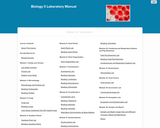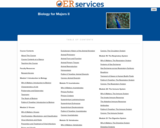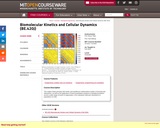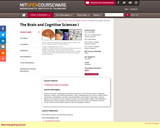
- Subject:
- Biology
- Material Type:
- Unit of Study
- Provider:
- Rice University
- Provider Set:
- OpenStax College




An introduction to biology intended for non-science majors. Focus areas include chemical foundations, cell structure and division, genetics, and evolution.

This template course was developed from generally available open educational resources (OER) in use at multiple institutions, drawing mostly from a primary work published by OpenStax College Concepts of Biology, but also including additional open works from various sources as noted in attributions on each page of materials.

This material is labwork meant to be used in conjunction with the Candela "Biology II" course.

Biology, The Cell is an unit of study no. 3 of the Biology full course. It is grounded on studying cells, including cell structure, structure and function of plasma membranes, metabolism, cellular respiration, photosynthesis, cell communication, and cell reproduction.

This 8-minute video lesson presents an overview of types of immune responses. It looks at the difference between innate and adaptive immunity and the differences between humoral adaptive immunity and cell-mediated adaptive immunity. [Biology playlist: Lesson 52 of 71].

Module 1: Introduction to Biology
The Characteristics of Life
Prokaryotes and Eukaryotes
Taxonomy
The Study of Biology
Module 2: Chemistry of Life
Atoms and Elements
Atomic Bonds
Functional Groups
The pH Scale
Chemical Reactions
Thermodynamics
Assignment: Biological Astronaut
Module 3: Important Biological Macromolecules
Proteins
Lipids
Carbohydrates
Nucleic Acids
Comparing Biological Macromolecules
Assignment: Nutritionist for a Day
Module 4: Cellular Structure
Microscopy
Organelles
The Cytoskeleton
The Cell Surface
Assignment: Cell Builder
Module 5: Cell Membranes
Structure of the Membrane
Kinds of Transport
Endocytosis and Exocytosis
Assignment: Membranes Alive!
Module 6: Metabolic Pathways
Redox Reactions
Photosynthesis
Cellular Respiration
Fermentation
Assignment: Observing Energy Transactions
Module 7: Cell Communication
Signaling Molecules and Cellular Receptors
Propagation of the Signal
Response to the Signal
Signaling in Single-Celled Organisms
Module 8: Cell Division
Chromosomes and DNA Packaging
The Cell Cycle
Cell Cycle Checkpoints
Meiosis
Genetic Diversity
Errors in Chromosome Number
Assignment: Mitosis and Meiosis Internet Quests
Module 9: DNA Structure and Replication
Storing Genetic Information
DNA Base Pairs and Replication
DNA Mutations
Assignment: Which Has More DNA?
Module 10: DNA Transcription and Translation
Transcription
Translation
Prokaryotic Transcription and Translation
The Central Dogma
Module 11: Gene Expression
Regulation of Gene Expression
Prokaryotic Gene Regulation
Eukaryotic Gene Regulation
Assignment: How Mutations Work
Module 12: Trait Inheritance
The Father of Genetics
Beyond Dominance and Recessiveness
Heredity and Disease
Genetics and the Environment
Assignment: Dragon Genetics
Module 13: Theory of Evolution
Charles Darwin
Evidence for Evolution
Mutations and Evolution
Phylogenetic Trees
Module 14: Modern Biology
Key Technologies
Biotechnology Applications
Risks and Benefits of Genomic Science
Assignment: When Jabberjays Attack!

Module 1: Introduction to Biology
Characteristics of Life
Prokaryotes and Eukaryotes
Taxonomy
The Study of Biology
Module 2: Viruses
Viral Evolution, Morphology, and Classification
Virus Infections and Hosts
Prevention and Treatment of Viral Infections
Prions and Viroids
Module 3: History of Life
Evolution
Speciation
The Evolution of Populations
Phylogenies and the History of Life
Module 4: Prokaryotes
Prokaryotic Diversity
The Structure of Prokaryotes
Prokaryotic Metabolism
Bacterial Diseases in Humans
Beneficial Prokaryotes
Module 5: Protists
Characteristics of Protists
Groups of Protists
Ecology of Protists
Module 6: Fungi
Characteristics of Fungi
Classifications of Fungi
Ecology of Fungi
Fungal Parasites and Pathogens
Module 7: Plant Diversity
Seedless Plants
Seed Plants
Module 8: Plant Structure and Function
Plant Structures
Transport of Water and Solutes in Plants
Plant Sensory Systems and Responses
Plant Growth
Plant Nutrition
Module 9: Plant Reproduction
Reproductive Development and Structure
Asexual Reproduction in Plants
Sexual Reproduction in Plants
Module 10: Animal Diversity
Evolutionary History of the Animal Kingdom
Animal Phylogeny
Animal Form and Function
Animal Primary Tissues
Animal Reproduction
Homeostasis
Module 11: Invertebrates
Phylum Porifera
Phylum Cnidaria
Superphylum Lophotrochozoa
Superphylum Ecdysozoa
Superphylum Deuterostomia
Module 12: Vertebrates
Chordates
Fishes
Amphibians
Amniotes
Reptiles
Birds
Mammals
Module 13: Overview of Body Systems
Integration of Systems
Control Systems
Cell Maintenance Systems
Support Systems
Module 14: The Nervous System
Components of the Nervous System
Neuron Communication
The Central Nervous System
The Peripheral Nervous System
Nervous System Disorders
Module 15: The Endocrine System
Types of Hormones
How Hormones Work
Regulation of Body Processes
Endocrine Glands
Module 16: The Reproductive System
Reproduction Methods
Human Reproductive Anatomy
Hormonal Control of Human Reproduction
Fertilization
Early Embryonic Development
Human Pregnancy and Birth
Module 17: Sensory Systems
The Senses
Somatosensation
Taste and Smell
Hearing and Vestibular Sensation
Vision
Module 18: The Circulatory System
The Circulatory System
Structure and Function of Blood
The Mammalian Heart
Blood Flow and Blood Pressure Regulation
Module 19: The Respiratory System
Systems of Gas Exchange
Gas Exchange across Respiratory Surfaces
Breathing
Transport of Gases in Human Bodily Fluids
Module 20: The Immune System
The Innate Immune Response
The Adaptive Immune Response
Antibodies
Module 21: The Digestive System
Digestive Systems
Nutrition and Energy Production
Digestive System Processes and Regulation
Module 22: The Excretory System
Osmoregulation and Osmotic Balance
Kidneys and Osmoregulatory Organs
Excretion Systems
Module 23: The Musculoskeletal System
Skeletal Systems
Bones
Joints and Skeletal Movement
Muscle Contraction and Locomotion
Module 24: The Integumentary System
Structure and Function of Skin
Accessory Structures of the Skin
Functions of the Integumentary System
Diseases, Disorders, and Injuries of the Integumentary System
Module 25: Ecology of Living Things
The Scope of Ecology
Biotic and Abiotic Factors
Biomes
Population Ecology
Community Ecology
Module 26: Ecology and the Environment
Energy in the Environment
Biogeochemical Cycles
Climate Change
Conservation Biology and Biodiversity

Includes the study of the gross and microscopic structure of the systems of the human body with special emphasis on the relationship between structure and function. Integrates anatomy and physiology of cells, tissues, organs, the systems of the human body, and mechanisms responsible for homeostasis.
Also available here:https://courses.lumenlearning.com/atd-herkimer-biologyofaging/
Table of Contents:
I. Chapter 1: Introduction to Human Aging
II. Chapter 2: Theories of Aging
III. Chapter 3: Cellular Aging
IV. Chapter 4: The Integumentary System
V. Chapter 5: Bone Tissue and The Skeletal System
VI. Chapter 6: The Skeletal Muscle System
VII. Chapter 7: The Nervous System
VIII. Chapter 8: The Special Senses
IX. Chapter 9: The Circulatory System
X. Chapter 10: The Immune System
XI. Chapter 11: The Respiratory System
XII. Chapter 12: The Digestive System
XIII. Chapter 13: The Urinary System
XIV. Chapter 14: The Reproductive System
XV. Chapter 15: The Endocrine System
XVI. Course Information
XVII. Term Research Project

"This course covers the principles of materials science and cell biology underlying the design of medical implants, artificial organs, and matrices for tissue engineering. Methods for biomaterials surface characterization and analysis of protein adsorption on biomaterials. Molecular and cellular interactions with biomaterials are analyzed in terms of unit cell processes, such as matrix synthesis, degradation, and contraction. Mechanisms underlying wound healing and tissue remodeling following implantation in various organs. Tissue and organ regeneration. Design of implants and prostheses based on control of biomaterials-tissue interactions. Comparative analysis of intact, biodegradable, and bioreplaceable implants by reference to case studies. Criteria for restoration of physiological function for tissues and organs."

" This course teaches the design of contemporary information systems for biological and medical data. Examples are chosen from biology and medicine to illustrate complete life cycle information systems, beginning with data acquisition, following to data storage and finally to retrieval and analysis. Design of appropriate databases, client-server strategies, data interchange protocols, and computational modeling architectures. Students are expected to have some familiarity with scientific application software and a basic understanding of at least one contemporary programming language (e.g. C, C++, Java, Lisp, Perl, Python). A major term project is required of all students. This subject is open to motivated seniors having a strong interest in biomedical engineering and information system design with the ability to carry out a significant independent project. This course was offered as part of the Singapore-MIT Alliance (SMA) program as course number SMA 5304."

This subject deals primarily with kinetic and equilibrium mathematical models of biomolecular interactions, as well as the application of these quantitative analyses to biological problems across a wide range of levels of organization, from individual molecular interactions to populations of cells.

This course will introduce the student to the major concepts of biotechnology. The student will discuss genetic engineering of plants and animals and the current major medical, environmental, and agricultural applications of each. There are also a variety of topics that this course will cover after ranging from nanobiotechnology to environmental biotechnology. Upon successful completion of this course, the student will be able to: identify and describe the fields of biotechnology; compare and contrast forward and reverse genetics and the way they influence biodiversity; compare and contrast systemic studies of the genome, transcriptome, and proteome; explain how genome projects are performed, and discuss the completion and the information processing in these projects; describe and explain the principles of existing gene therapies; design strategies that support genetic counseling; explain and analyze DNA fingerprints, and compare DNA fingerprints to non-DNA biometrics; describe and compare bioremediation technologies in air, water, and soil; design strategies for generating genetically modified organisms, and discuss ethical concerns; discuss emerging fields in biotechnology. (Biology 403)

Given the broad definition of biotechnology applications and products, it is easy to see how there is enormous overlap within the fields of cellular biology, microbiology, chemistry, and biomedical engineering. It is the goal of this textbook to provide foundational knowledge to begin building your biotechnology toolkit and enter an exciting career of making a difference through biotechnology.
This textbook first explores the fundamentals of laboratory science and biotechnology. Unit 1 begins with a dive into the foundation of biology and chemistry by asking what is life and what are the molecules of life? The end of the unit offers a primer into laboratory science; preparing solutions and operating basic lab equipment. Unit 2 brings readers through a vital tool of biomanufacturing, understanding the growth and control of microbes. Many biotechnology products are made by harnessing the work of microbes, and this unit explores this invisible and intriguing world of microorganisms. The final unit, molecular biotechnology, offers a more in-depth look at how biological molecules such as DNA and protein are manipulated into creating useful products.
Table of Contents
1 Unit 1. The Foundations of Biotechnology
Chapter 1. The Study of Life
Chapter 2. The Building Blocks of Life
Chapter 3. What is Biotechnology?
Chapter 4. Biotechnician Tools: Measurements & Uncertainty
Chapter 5. Biotechnician Tools: Preparing Solutions
Chapter 6. Biotechnician Tools: Basic Laboratory Equipment
2 Unit 2. Introduction to Biomanufacturing
Chapter 7. Cell Structure and Function
Chapter 8. Microbes
Chapter 9. Microbial Techniques
Chapter 10. Microbial Growth
Chapter 11. Control of Microbial Growth
3 Unit 3. Molecular Biotechnology
Chapter 12. Nucleic Acid Structure & Function
Chapter 13. Protein Structure and Function
Chapter 14. Laboratory Techniques: Nucleic Acids and Proteins
Chapter 15. Viruses, Vaccines, and the Immune System
Chapter 16. Immunochemistry

An advanced course covering anatomical, physiological, behavioral, and computational studies of the central nervous system relevant to speech and hearing. Students learn primarily by discussions of scientific papers on topics of current interest. Recent topics include cell types and neural circuits in the auditory brainstem, organization and processing in the auditory cortex, auditory reflexes and descending systems, functional imaging of the human auditory system, quantitative methods for relating neural responses to behavior, speech motor control, cortical representation of language, and auditory learning in songbirds.

Survey of principles underlying the structure and function of the nervous system, integrating molecular, cellular, and systems approaches. Topics: development of the nervous system and its connections, cell biology or neurons, neurotransmitters and synaptic transmission, sensory systems of the brain, the neuroendocrine system, the motor system, higher cortical functions, behavioral and cellular analyses of learning and memory. First half of an intensive two-term survey of brain and behavioral studies for first-year graduate students. Open to graduate students in other departments, with permission of instructor.

One summer in the 1960s a young Japanese researcher, with the help of a few high school students, chopped up ten thousand jellyfish. As a by-product of this harvest, they isolated a green fluorescent protein (GFP). Since then, GFP has triggered a revolution in our understanding of gene expression and signaling in live cells. In this seminar, we will examine how this small protein generates fluorescence, i.e. absorbs light of one wavelength and emits light of a longer wavelength. We will discuss how the color palette has been extended from green to blue, red and many other colors, based on protein engineering of GFP and the study of vividly colorful coral reefs. We will then investigate how these fluorescent proteins can be used to track the motion of DNA, RNA and protein in living cells, as well as to see waves of signaling molecules propagate across a cell. GFP is also a powerful tool for fluorescent imaging of whole organisms, from worms to mice, and we will see how it has been used in tracking the spread of cancer cells, controlling malaria and in understanding how neuronal connections form. In this seminar, we will explore this wonderful protein as well as other important methods and reagents for fluorescent imaging. This course is one of many Advanced Undergraduate Seminars offered by the Biology Department at MIT. These seminars are tailored for students with an interest in using primary research literature to discuss and learn about current biological research in a highly interactive setting. Many instructors of the Advanced Undergraduate Seminars are postdoctoral scientists with a strong interest in teaching.

This course will cover the origins of cancer and the genetic and cellular basis for cancer. It will examine the factors that have been implicated in triggering cancers; the intercellular interactions involved in cancer proliferation; current treatments for cancer and how these are designed; and future research and treatment directions for cancer therapy. Upon successful completion of this course, the student will be able to: explain how the perception of cancer and theories of its causes have changed throughout history because of important discoveries made by scientists, researchers, and physicians; summarize the importance of understanding cell biology in the study of cancer, its causes, it progression, and its treatment; outline the transcription and translation processes used to convert DNA into proteins and what changes occur that convert proto-oncogenes into oncogenes and lead to unchecked cell growth and cancer; compare and contrast the mechanisms by which activation of oncogenes, loss of tumor suppressors, loss of cell cycle checkpoints, and development of faulty DNA repair lead to cancer; describe the various cancer prevention mechanisms including risk assessment, screening, and lifestyle and environmental modification; list the past, current, and future cancer treatments and the mechanism by which these target cancer causing cells. (Biology 404)